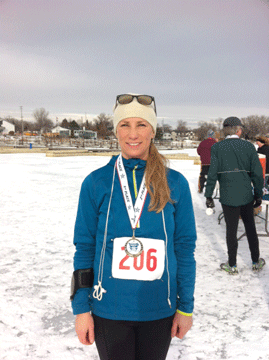April 18, 2013 at 11:17 a.m.
Donor awareness advocate says she received more than she gave by donating part of liver
The month of April is special for Sandi (Anderson) Williams, as national “Donate Life Month” and Organ Donor Awareness Month.
But, this marks just the second spring in which she has been aware of those campaigns.
In August 2011, she learned that a friend, her father-in-law, Bob Williams, who was suffering from biliary cirrhosis of the liver (possibly brought on by exposure to Agent Orange during war service in Vietnam) had been designated as a candidate for a live organ donation. Sandi got the news from Bob’s son, Travis Williams. When she was a child, Sandi’s family moved to Shafer in 1981 and she met Travis at Taylors Falls Elementary School in sixth grade. Sandi and Travis became close through the years, and they married after graduating together from the former Taylors Falls High School. Sandi said Bob became like a second father to her. She was lying on a couch two summers ago when Travis relayed the organ candidacy news about his father. Surprising herself as much as Travis, Sandi rose quickly from the couch, and announced that she wished to be that donor.
“That’s how I do a lot of things,” she observes. “I act first, and think about it later.” Travis thanked her but said that he could not ask that of her. Bob reacted in the same way, she recalls. Yet, the next day, during some time off from her receptionist work at Animal Medical Center in Lindstrom, “I went to a hospital,” she said, “and got my blood checked.” With a B negative blood type, Sandi was given about a one-in-six chance of being considered as a match for a liver for Bob, but the odds proved to be in their favor. About a month later, on Sept. 15, she underwent a litany of further tests that were required before surgeons could schedule a day for a live transplant. “I had every screening for every disease you could possibly imagine,” Sandi said. She passed all of the tests, and Bob, Travis and other family members had come to embrace Sandi and her offer.
She and Bob each spent eight hours in surgery Nov. 9, 2011, at the University of Minnesota. Sandi was the first to receive anesthesia, and the last to awaken following their procedure. Doctors had taken 60 percent of the liver from her body for Bob. His body accepted the liver, but pneumonia, blood clots and kidney failure caused Bob to lose his life within four weeks, on Dec. 2. “It’s not an easy story to tell,” Sandi said. “He died. He wasn’t supposed to die.” Another change in Sandi’s life since her surgery is that she and Travis have divorced, but they remain close friends. “Their family has been of continuous support to me,” she said, adding that she would do nothing any differently, appreciative of the last few months she could experience with Bob, whom she said was really battling illness throughout his retirement. “He was getting sicker and sicker,” before the surgery, Sandi said. “I’m glad that I got the opportunity. He didn’t want to live that way any more.”
Her remaining liver began to regenerate, as a healthy one should, and the organ is close to its original size, she said. She did not know what to expect from the rest of her recovery, which she says was difficult from the start. “I couldn’t lift, I couldn’t drive, I couldn’t do much of anything,” she said. “I’m still healing to this day.” About the tests, her surgery and recovery, she said, “it’s scary, it’s frightening. It took a toll, but it really showed me what I was made of. “It’s boosted my confidence, and it changed my life.”
She returned to the Animal Medical Center one month after her surgery, starting back slowly on a part-time schedule. Away from the clinic, where she has worked eight years, she began to spend less time on a couch and more time on her feet. Sandi would often end a day feeling “completely exhausted,” she said, but she began to walk outdoors, and during a typical hike last spring, she felt the will to pick up her pace and jog or run for what she figures was about a mile. By the end of last summer, she was running distances of more than three miles, and completed her first 5K during Chisago City’s Ki-Chi-Saga Days festival. She has finished eight more events through last fall and the winter, locally during Celebration of the Lakes in January but also traveling to run in Grantsburg, Wis., Minneapolis, and around lakes Como and Phalen in St. Paul.
When not welcoming families with their pets to the Animal Medical Center, or working a second job in which she waits tables at a café that her own father operates in Amery, Wis., Sandi has been training for her first 10K race, which covers a distance of more than six miles. She dedicates each of her road events to other people, like to her late father-in-law, and recently to a family friend who was entering military duty on the day of one of Sandi’s races. “I’m running because I can, and because someone else can’t,” she said. “I’m happy, I’m healthy, and I’m strong.” Sandi is likely to spend more time speaking up each April about the benefits for donors and recipients through organ donation.
“I’m hoping to be an advocate,” she said. “I want people to look at their driver’s licenses and check their donor cards. As a live donor, people need to sign their donor cards. Make sure your family knows your wishes. Through the healing that I’ve done, I want to spread the word in every way that I can.”





Comments:
Commenting has been disabled for this item.